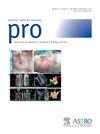A Comparison of Radiosurgical Planning Techniques for the Treatment of Trigeminal Neuralgia
IF 3.5
3区 医学
Q2 ONCOLOGY
引用次数: 0
Abstract
Purpose
To survey and analyze the current peer-reviewed literature on physical aspects of radiosurgical treatment of trigeminal neuralgia (TN), and objectively determine the comparative differences between common treatment planning techniques/modalities when variability in computed tomography and magnetic resonance imaging data sets and clinical approaches are minimized.
Methods and Materials
Example treatment plans were created from 8 distinct planning approaches on a unique computed tomography and magnetic resonance imaging data set. Treatment plan selection comprised Gamma Knife, physical cone, and multileaf collimator-based plans. The prescription was standardized between plans to 85 Gy at the isocenter, as well as the location of the treatment isocenter. Dose distributions were characterized using multiplanar isodose line comparisons, dose line profiles in 2 dimensions, gradient indices, dimensional and volumetric analysis of 50% and 80% isodose coverage, and maximum (0.1 cc) dose to the brainstem as singularly contoured on the unique imaging data set.
Results
Dose coverage, distribution shape, dose line profiles, and gradients differ significantly between Gamma Knife, physical cone, and multileaf collimator-based planning techniques, even when dose prescription, treatment isocenter, and imaging data set/anatomy are identical between treatment plans. Gamma Knife (4 mm collimator) provides the broadest coverage of the trigeminal nerve, most closely approximated by the 5 mm physical cone linear accelerator (LINAC)-based plan. Contrastingly, the smallest cross-sectional coverage in this treatment plan selection was created by the 4 mm LINAC physical cone. All dose distributions were approximately spherical except the 11-arc physical cone LINAC-based plan, which produces a more elongated distribution (broadest adjacent to the brainstem).
Conclusions
The selection of a radiosurgical technique for TN should be weighed in the context of differences in dose distributions between treatment techniques, as demonstrated by the plans analyzed in this study. It cannot be assumed that all TN radiosurgical techniques produce the same dose distribution, either to the trigeminal nerve or adjacent normal tissues. Differences between planning techniques may be amplified in real clinical scenarios with differences in clinical approach and anatomy.
三叉神经痛放疗计划技术的比较。
目的:调查和分析目前同行评议的三叉神经痛(TN)放射外科治疗物理方面的文献,客观地确定在计算机断层扫描和磁共振成像数据集以及临床方法的可变性最小的情况下,常见治疗计划技术/模式之间的比较差异。方法和材料:根据独特的计算机断层扫描和磁共振成像数据集,从8种不同的计划方法创建示例治疗方案。治疗方案选择包括伽玛刀、物理锥和基于多叶准直仪的方案。处方标准化之间的计划到85 Gy在等中心,以及治疗等中心的位置。剂量分布通过多平面等剂量线比较、二维剂量线剖面、梯度指数、50%和80%等剂量覆盖率的尺寸和体积分析以及在独特的成像数据集上对脑干的最大剂量(0.1 cc)的奇异轮廓来表征。结果:剂量覆盖、分布形状、剂量线轮廓和梯度在伽玛刀、物理锥和基于多叶准直仪的计划技术之间存在显著差异,即使在剂量处方、治疗等中心和成像数据集/解剖结构在治疗方案之间是相同的。伽玛刀(4毫米准直器)提供了最广泛的三叉神经覆盖范围,最接近于5毫米物理锥线性加速器(LINAC)为基础的计划。相比之下,在这个治疗方案选择中,最小的横截面积是由4mm的LINAC物理锥产生的。所有剂量分布近似为球形,除了11弧物理锥基于linac计划,产生更细长的分布(最宽的脑干附近)。结论:正如本研究分析的计划所证明的那样,TN放射外科技术的选择应在治疗技术剂量分布差异的背景下进行权衡。不能假设所有的TN放射外科技术对三叉神经或邻近的正常组织产生相同的剂量分布。由于临床方法和解剖结构的不同,规划技术之间的差异可能会在实际临床情况下被放大。
本文章由计算机程序翻译,如有差异,请以英文原文为准。
求助全文
约1分钟内获得全文
求助全文
来源期刊

Practical Radiation Oncology
Medicine-Radiology, Nuclear Medicine and Imaging
CiteScore
5.20
自引率
6.10%
发文量
177
审稿时长
34 days
期刊介绍:
The overarching mission of Practical Radiation Oncology is to improve the quality of radiation oncology practice. PRO''s purpose is to document the state of current practice, providing background for those in training and continuing education for practitioners, through discussion and illustration of new techniques, evaluation of current practices, and publication of case reports. PRO strives to provide its readers content that emphasizes knowledge "with a purpose." The content of PRO includes:
Original articles focusing on patient safety, quality measurement, or quality improvement initiatives
Original articles focusing on imaging, contouring, target delineation, simulation, treatment planning, immobilization, organ motion, and other practical issues
ASTRO guidelines, position papers, and consensus statements
Essays that highlight enriching personal experiences in caring for cancer patients and their families.
 求助内容:
求助内容: 应助结果提醒方式:
应助结果提醒方式:


